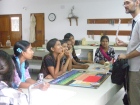I’m very glad and thankful that Ken from WriteOutLoud and KenThinksOutLoud did agree on writing this post and sharing his very precious experiences with the VAK learning style model here.
***
Recently, on this blog, Ute wrote about three learning styles when learning a new language. These styles are referred to as Visual, Aural (or Auditory) and Kinaesthetic. Shortly afterwards, she kindly asked me to do a guest post on the use of VAK, as it’s known, in British schools. I am delighted to do just that.
What is VAK?
VAK is learning style model created by Neil Fleming in 1987 which grew out of earlier neuro-linguistic programming models. Space doesn’t allow going into detail but simply, this theory works on the assumption that learners have a preference for one of three specific learning styles:
- Visual learners absorb information best through pictures. Visual aids such as slides and diagrams suit them perfectly. These are the bookworms and often hate music playing in the background as it disturbs them. “I get the picture.”
- Auditory learners learn best through listening. They respond best to lectures and tape recordings and so on. These learners may enjoy having music on in the background while studying or memorise facts through song and mnemonic sentences. “I think that sounds OK.”
- Kineasthetic or tactile learners learn through experience. Science projects, experiments and work involving ‘hands-on’ activity are most successful for these learners. These types are often the ones found repeatedly copying out facts they need to remember before tests. “This feels right to me.”
This model of learning styles was widely adopted by state schools in the nineties and continues to be one of the bedrocks of British educational practice today. Schools throughout the country use VAK on a daily basis. School inspectors (OFSTED) look for evidence that teachers are catering for all three types of learners in their classrooms. Terminology changes (VAK is also known as VARK and VAKT for instance) and different models are adapted from time to time, but they often amount to pretty much the same thing which is probably why VAK has proven so enduring.
Controversies
Though VAK is well established in British schools, this doesn’t mean it doesn’t court controversy – not least because of the lack of methodological evidence for the model. Some teachers now think the model has no validity as a result.
However, though you will normally find VAK referred to with respect to education, it really belongs to the sphere of psychology – a subject not known for its ‘laws’ and with good reason. The brain is staggeringly complicated and still very little is known about how the mind actually work. VAK is a theory and not one which lends itself to testing very easily. Nevertheless, even if a teacher doesn’t agree with the model, the chances are they already use it unconsciously because variety of learning styles is a good thing.
 Those who do use VAK properly find the model to be extremely helpful and it improves their teaching. I know from personal experience that the quality of my teaching instantly improved as soon as I began using the model. In fact, it’s so good that I teach VAK to my students to empower their own learning and revision at home.
Those who do use VAK properly find the model to be extremely helpful and it improves their teaching. I know from personal experience that the quality of my teaching instantly improved as soon as I began using the model. In fact, it’s so good that I teach VAK to my students to empower their own learning and revision at home.
Those who dislike the model inevitably misuse it or don’t understand it. VAK is a tool to be used as found helpful rather than as a rigid set of rules. Some teachers make the mistake of thinking students have to learn only using the strongest learning style and this can be harmful. It’s a mistake to think that we are strong in just one area. Sportsmen are going to be obvious kinaesthetic learners but they must also be strong visually for good hand-eye coordination. Linguists will usually be strong aural learners but will also need good visual skills for reading a variety of alphabets. Musicians, as we’ll see, tend to be strong in all three.
So how does VAK help?
The aim of the model is to identify your relative strengths in each of the three areas and then do two things:
- Use your strongest area as your primary method of learning and revising.
- Exercise your weaker areas.
This second point is vital. No one learns simply by seeing or listening or doing. We rely on different areas according to the situation. For instance, although I’m very much a visual learner, sometimes I need to hear information or even speak it out loud for myself to truly understand it. Many students have found that a passage of text incomprehensible to them in the classroom is easy when they read it out loud (Aural) at home or walk around the room as they revise it (Kinaesthetic).
 It is also a fallacy to think we only use one area at a time. I’m a trained musician as well as an academic. When I study new pieces I’m using my visual skills to read the sheet music and observe my hands on the instrument; I use my aural skills to hear the sounds I produce and adjust accordingly; and I use kinaesthetic skills as my fingers move around the instrument. It’s no coincidence there is a large body of evidence which indicates learning a musical instrument is one of the best ways to develop a child’s thinking abilities in all subject areas. A musician’s brain fires very differently to a non-musician’s. (download a pdf of a study on this here)
It is also a fallacy to think we only use one area at a time. I’m a trained musician as well as an academic. When I study new pieces I’m using my visual skills to read the sheet music and observe my hands on the instrument; I use my aural skills to hear the sounds I produce and adjust accordingly; and I use kinaesthetic skills as my fingers move around the instrument. It’s no coincidence there is a large body of evidence which indicates learning a musical instrument is one of the best ways to develop a child’s thinking abilities in all subject areas. A musician’s brain fires very differently to a non-musician’s. (download a pdf of a study on this here)
Variety is the Spice of Life
This mention of music brings us nicely to one of the key aspects of VAK: variety of learning styles is good for the learner.
I’ve been a music teacher for over twenty years and my private students have often struggled with trying to fit in instrumental practice during the months leading up to exams – until, that is, I point out just how their music practice can help their revision.
The principle is simple: break up revision time with short bursts of music practice. Most revision techniques tend to be heavy on the visual side of learning (they have to be, students are revising from text books most of the time) and concentration wanes after 20-40 minutes. Often students take a break and rest but this encourages the mind to turn off making it harder to get started again. By practising an instrument for 10-20 minutes the brain remains active, aural and kinaesthetic skills are honed and the student feels refreshed and ready to tackle revision again. By taking ‘active breaks’ using different learning styles, students end up with better quality studying.
Similarly, a good teacher will endeavour to make sure his or her lessons have a variety of tasks suitable for all types of learners. VAK will normally be covered in each lesson. For instance, in Science the teacher may well explain the principles (Aural/auditory), while the students read the text book along side or a powerpoint presentation runs alongside (Visual). Then the students will work on an experiment themselves (Kinaesthetic). Students end up with multiple opportunities to grasp the subject matter and all three modes of learning are exercised.
This is an essential aspect of life, of course. I may well prefer doing things with my hands, but if my job requires listening to customers on the end of the phone, I’ve got to be able to concentrate and understand the conversation. Public speakers who mumble into their notes usually lose their audience within minutes. Here, the medium is primarily aural – the audience are listening – and this is difficult to maintain for long periods so holding eye contact means your listener is engaging visually with you at the same time. This helps them to concentrate for longer – as long as the speaker doesn’t stare at any one person too long! My wife, when speaking, often has her audiences get up and do exercises deliberately to help Kinaesthetic members too.
VAK for personal use
Understanding your own learning style can improve the way you learn (as Ute was sharing on her own post about learning styles). When I moved to Bangladesh with my family in 2008 I had little experience of learning languages and was terrified of attempting a whole new language with a completely different alphabet.
Thankfully, 10 years of using VAK in the classroom was an empowering experience. I was never going to be someone to hear a few words and start speaking them confidently. That just doesn’t work for me. As a visual learner I realised what I had to do was what most students leave until last – I learned to read Bangla/Bengali script. I grasped the complex alphabet with relative ease while my wife (a strong Aural and Kinaesthetic learner) hated it. While she became fluent in conversations with Bangladeshis I took longer but quickly developed a much stronger vocabulary. We took different routes but five years later we both speak with many Bangladeshi friends confidently and I enjoy accessing a wealth of Bengali literature.
VAK is a wonderful tool which you can use in the classroom, with your children, for public speaking and for your own enjoyment of learning. It’s not a panacea for all educational ills but it is an intuitive model which has helped millions of children in the UK to learn more effectively and enjoyably.
 Ken is a British freelance writer, editor, musician, educational consultant and avid blogger. He lived with his wife and two children in Bangladesh for five years working for an NGO called LAMB before returning to the UK at the end of 2013. Last year he turned full-time as a freelance writer and has a novel plus a number of other books due to be published shortly. He writes about life in Bangladesh and Britain on his blog kenthinksaloud and is building a blog about all things writing-related on WriteOutLoud.
Ken is a British freelance writer, editor, musician, educational consultant and avid blogger. He lived with his wife and two children in Bangladesh for five years working for an NGO called LAMB before returning to the UK at the end of 2013. Last year he turned full-time as a freelance writer and has a novel plus a number of other books due to be published shortly. He writes about life in Bangladesh and Britain on his blog kenthinksaloud and is building a blog about all things writing-related on WriteOutLoud. Categories: Being multilingual, Multilingual children, Multilingualism, School








Thanks for the opportunity to guest post for you Ute – it was a real pleasure 🙂
LikeLike
Very nicely done summary!
Just for fun, to get a class thinking about this I do this exercise: Ask the whole class to think about the last concert they attended and then give them 30 seconds to each compose a ten-second summary of the event. I then pick 5 or 6 students and ask them to say their piece. Some will talk about:
– what they say only
– what they heard only
– how it made them feel only
– a combination
I then ask the class to think about their own response and see which of the four bullets is closest to theirs. This, then transitions to a talk of various aspects of learning styles.
LikeLike
That’s a brilliant idea! I shall add that to my collection of starter exercises as a good activity for identifying VAK tendencies. 🙂
LikeLike
Reblogged this on Giovedì Italiano and commented:
Very interesting! I’m born “V”, learned to be “A”, still trying to better my “K” skills.
LikeLike
So sports players are ‘obviously kinesthetic’ but a music teacher like you can be visual? Hmmmmm
LikeLike